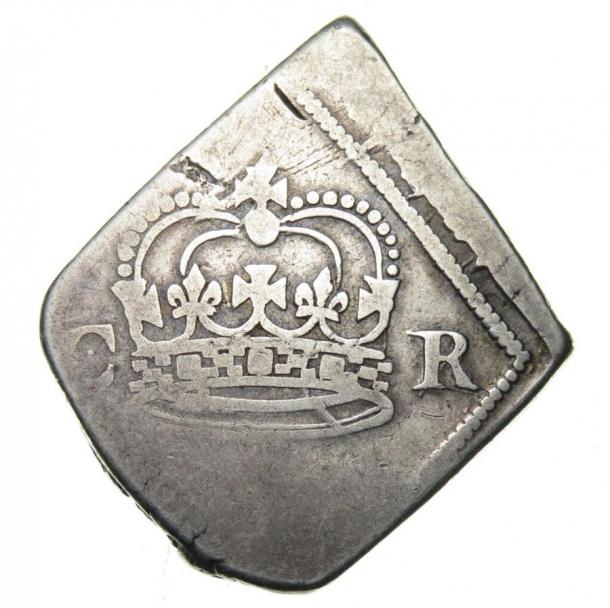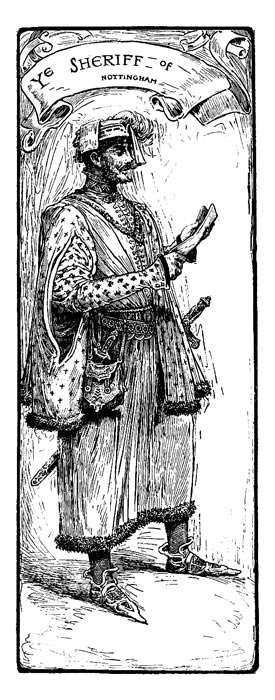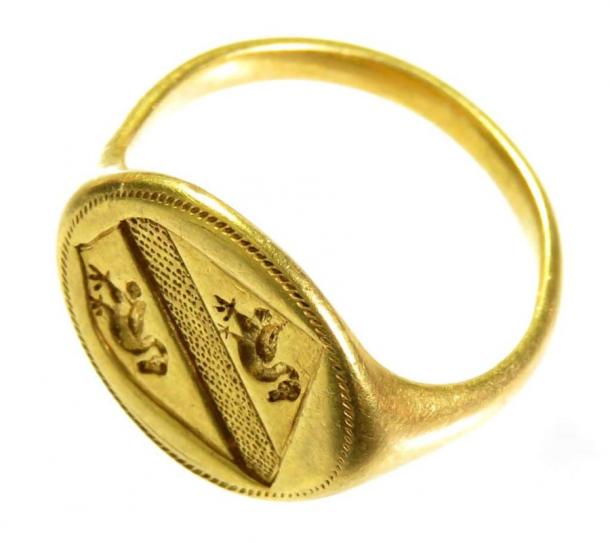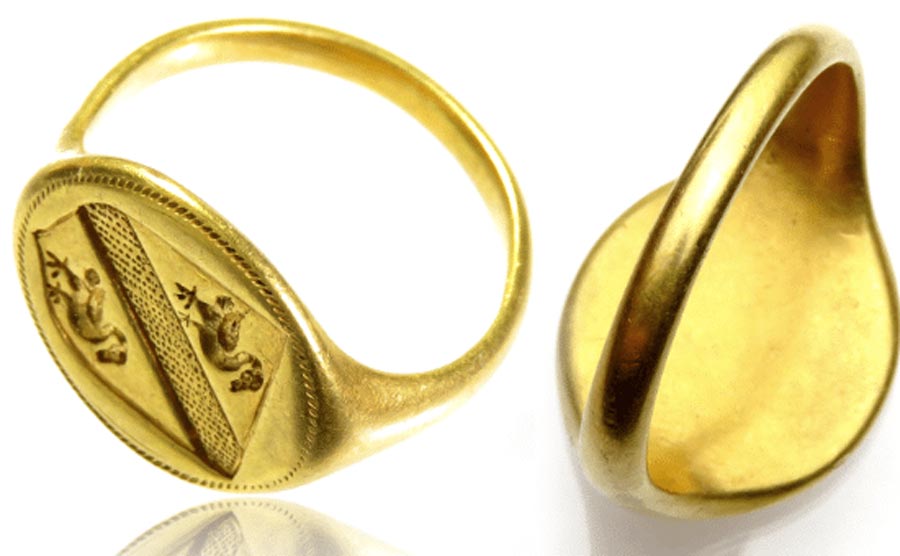Gold Ring that Belonged to Real Sheriff of Nottingham Sold
On March 24 Hansons Auctioneers in Derbyshire, England began taking bids on one of the more fascinating historical artifacts they’ve put up for auction. The item they’re selling is a flashy golden signet ring that once belonged to the High Sheriff of Nottingham.
No, not that Sheriff of Nottingham. The Sheriff who sought in vain to capture the virtuous outlaw Robin Hood is strictly the stuff of legends.
The ring being auctioned off belonged to a real-life, 17th century version of the Sheriff of Nottingham. This particular sheriff never chased Robin Hood around Sherwood Forest. But he did arrest actual lawbreakers who were caught carrying out their illegal affairs within the city limits of the real Nottingham, and he did so while flashing a fancy piece of finger jewelry that helped attest to his high status.
Adding more color to the story of the High Sheriff of Nottingham’s signet ring is how it was found. It was not recovered by a professional archaeologist, but was instead found in July 2020 by an amateur treasure hunter scanning a section of farmland near Rushcliffe, Nottinghamshire with a metal detector.
For Graham Harrison, 64, a retired merchant navy engineer officer from Lincoln, Lincolnshire, the discovery of the valuable 17th century ring represents the highlight of his 10-year “career” as a detectorist.
“It was the first big dig after lockdown on a glorious day,” Harrison remembered, sharing the details of his discovery in a Hansons press release. “We were searching two fields. Other detectorists kept finding hammered coins but I’d found nothing. Then I suddenly got a signal. I dug up a clod of earth but couldn’t see anything. I kept breaking up the clod and, on the last break, a gold ring was shining at me.”
- Vikings Used Sherwood Forest Long Before It Was Known as the Hideout of Robin Hood
- Medieval Ring Found in Robin Hood’s Forest May Net a Small Fortune

One of the silver hammered coins, found in the same area. (Hansons Auctioneers)
Ecstatic at his find, Harrison contacted local authorities, who arranged for the ring to be examined by specialists from the British Museum’s Portable Antiquities Scheme. But even before this evaluation was complete, Harrison already knew the significance of what he’d found.
“I knew it was a signet ring and started doing some research,” he explained. “When I found out about the connection to the Sheriff of Nottingham it made me smile. There can’t be many people who’ve found anything like that.”
After the experts verified the legitimacy of the ring and returned it to his possession, Harrison decided to put it up for auction.
“I’m only selling it because it’s been stuck in a drawer. I hope it will go to someone who will appreciate its historical value.”
The rare and exquisitely crafted gold ring is in excellent condition. It was expected to sell at auction for somewhere between £6,000 and £8,000 British pounds, which is the equivalent of $8,000 to $10,500. It finally went under the hammer for a respectable £8,500 ($11,200).
- Robin Hood: Too Good to Be True - A Real Folk Hero or a Romantic Embellishment?
- How to Be A Chivalrous Knight in Shining Armor: Follow the Code!

Vintage Illustration of a Sheriff of Nottingham (Morphart / Adobe Stock)
Introducing Sir Matthew Jenison, High Sheriff of Nottingham
The gold ring carries the coat of arms of the Jenison family. The Jenisons were prominent in English politics in the 16th and 17th centuries, occupying various government positions and political offices in Nottinghamshire County (where the city of Nottingham is located) in England’s East Midlands region.
“The ring has survived in near perfect condition and the front face bears a detailed engraving of the Jenison family arms, two swans separated by a diagonal bend,” said Hansons consultant Adam Staples. “This would have been pressed into melted wax in order to seal the family crest on important letters and documents.”
The Nottinghamshire branch of the Jenison family were first elected as aldermen in local councils starting in 1580. Several Jenisons would later serve as mayors in Nottinghamshire towns and cities, once that office was established in a 1626 charter.
The experts have confirmed that the original owner of the gold signet ring was one Sir Matthew Jenison.
Trained as a lawyer, Matthew was knighted in 1683 at the age of 29 and assumed the office of High Sheriff of Nottingham in that same year. The office of High Sheriff was actually separate from the office of sheriff, so there were really two individuals who carried the title “Sheriff of Nottingham” at that time (and in the years beyond). Sir Matthew remained High Sheriff for one year, and later went on to serve as a member of the Parliament representing the village of Newark.
Ironically, Sir Matthew shared an important characteristic with the fictional Sheriff of Nottingham. Like the dastardly sheriff who harassed Robin Hood, Sir Matthew was ethically challenged and apparently quite the scoundrel. He was sued several times for various forms of misconduct, and was eventually sentenced to prison for failing to pay his legal fees from one of these suits. He died while incarcerated in 1734, remembered more for his misdeeds than his positive accomplishments.

The signet ring holds the coat of arms of Sir Matthew Jenison, once High Sheriff of Nottingham. (Hansons Auctioneers)
Saluting All Sheriffs of Nottingham, Both Real and Imagined
Any reference to the Sheriff of Nottingham will inevitably evoke an association with the legendary Robin Hood.
During Robin Hood’s time robbing the rich to give to the poor, the Sheriff of Nottingham was identified as his most implacable enemy. In the end Robin Hood always got the best of the Sheriff, who was ruthless and intimidating but ultimately overmatched by the resourceful Robin and his band of Merry Men. The personal rivalry between Robin Hood and the Sheriff of Nottingham was fierce and long-lasting but ultimately one-sided, as the good represented by Robin triumphed over the evil represented by the Sheriff time and time again.
It has often been asked, were the characters of Robin Hood and the Sheriff of Nottingham based on actual living people? They might very well have been, although it is a difficult if not impossible assertion to prove. But what is indisputable is that more than 1,000 men and women have served as either Sheriff or High Sheriff of Nottingham over the past several centuries, holding real authority in real law enforcement positions.
The first mention of Robin and his exploits occurred in literature circulated during the late 14th century, and it is believed his fictional adventures were set in the 13th century. Interestingly, the first Sheriff appointed to this position took office in the year 1449, which is well after the time of the Norman conquest and therefore later than the time period in which the legend of Robin Hood is set. This means the Sheriff of Nottingham from the story must have been based on a High Sheriff, and one of Jenisons predecessors, and would actually have been High Sheriff of Nottinghamshire, Derbyshire and the Royal Forests. So the fictionalized character must have been adjusted over time.
Nevertheless, this imaginary sheriff was still based on reality. Sheriffs in medieval times were representatives of the king, and they acted as the Crown’s representatives in the regions to which they were assigned. Their job was to of investigate criminal activity, collect rents and taxes, and head off any rebellions that might be brewing in their particular areas. If any real-life Robin Hoods showed up in their jurisdictions, it would have been their responsibility to capture them and put them in jail as quickly as possible.
What is perhaps most surprising about the real positions of Sheriff of Nottingham and High Sheriff of Nottingham is that both offices still exist today. At this point the duties of each position is entirely ceremonial, as both exist exclusively to help promote and support tourism in the city.
But ceremonial or not, there is a line of uninterrupted continuity that links every man or woman who has served as a Sheriff with those who held that office in the past. The latest versions of Sheriff and High Sheriff don’t wear gold rings to signal their importance, but they do share an undeniable connection with Sir Matthew Jenison and all his predecessors and successors nonetheless.
Top image: Gold signet ring bearing the coat of arms of Sir Matthew Jenison, once Sheriff of Nottingham. Source: Hansons Auctioneers
By Nathan Falde

















